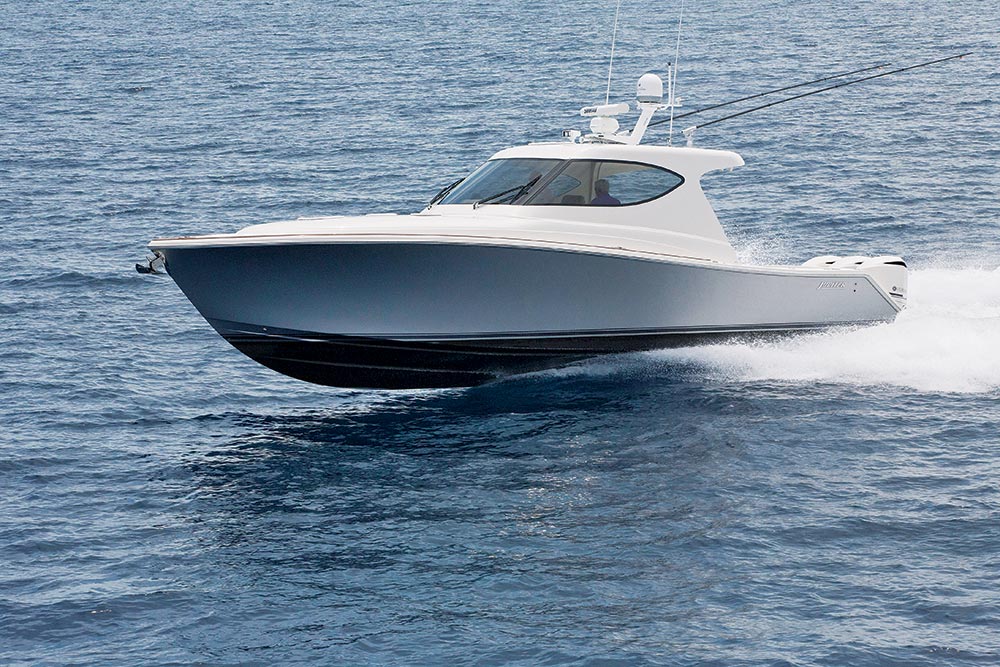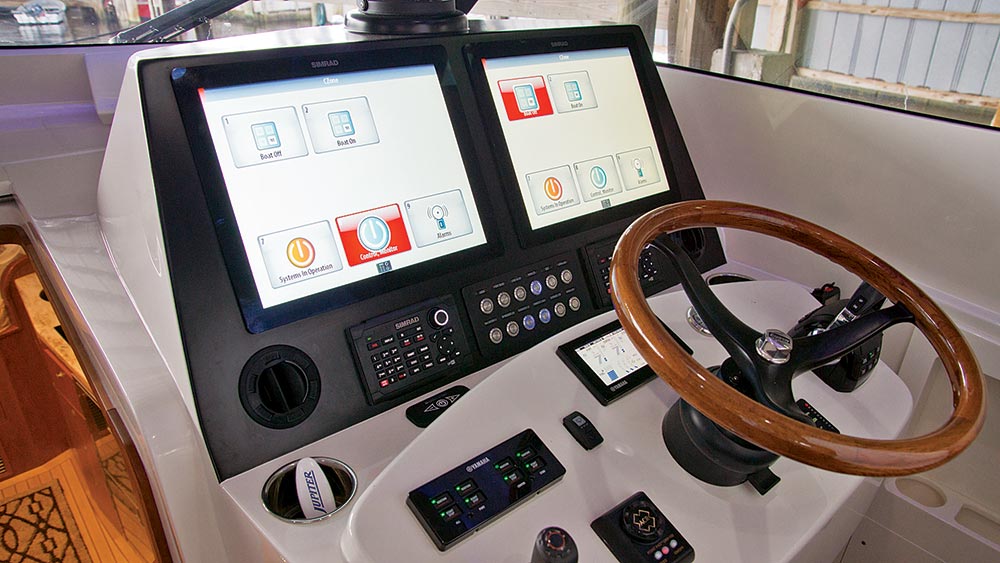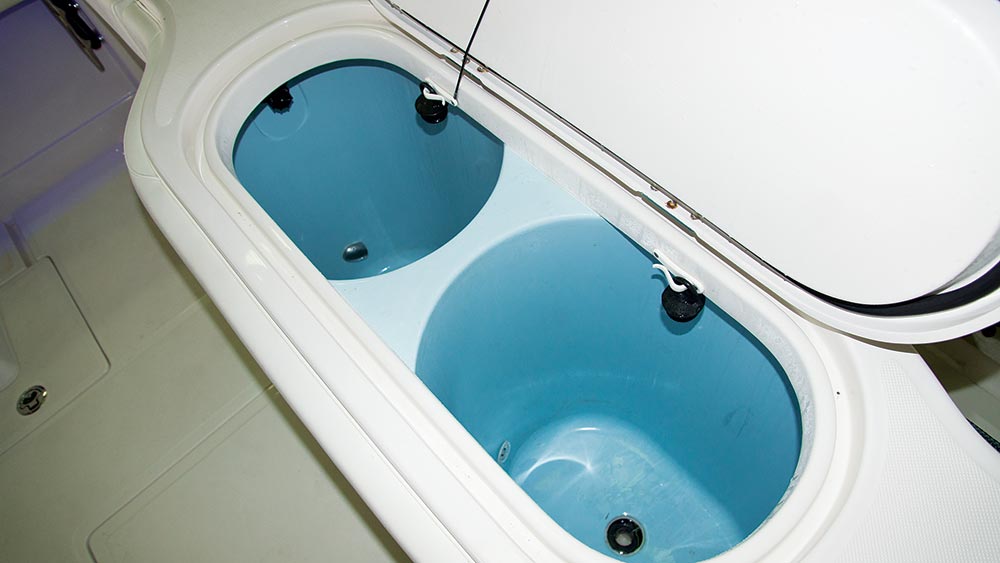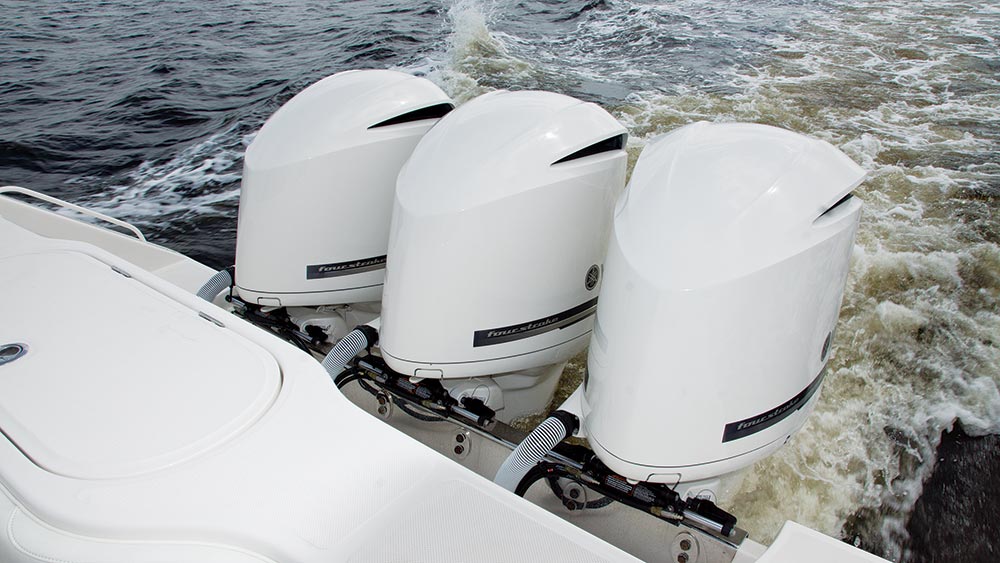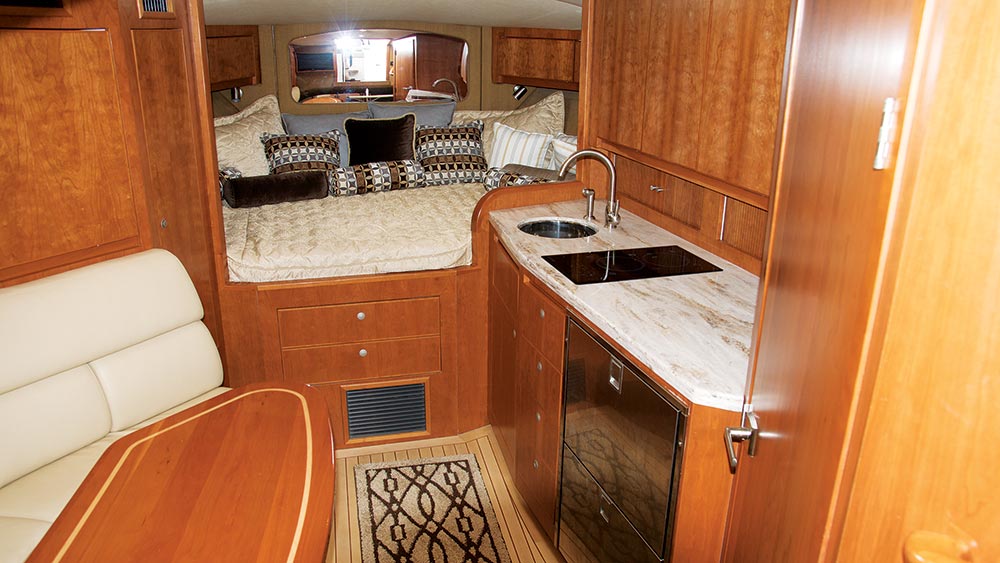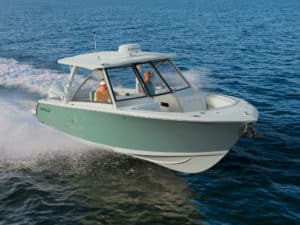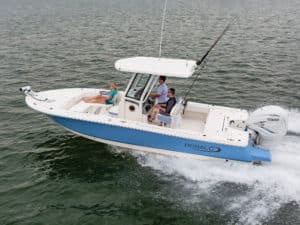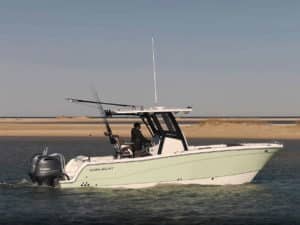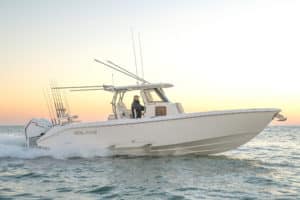(Be sure to click through all the images in the gallery above.)
Jupiter Marine is a busy place, with workers laying multiple keels inside and waxing gleaming vessels outside. Todd Albrecht, vice president of sales, led me through the factory to the next new 41 Sport Bridge (click for video) that was taking shape.
Jupiter builds boats to order, and its clients are well-to-do, private people who might be pulling their offshore boats behind megayachts while underway to their favorite fishing waters in the Bahamas, the Caribbean or Bermuda. I got an eyeful of what made Jupiters solid, soft riding and perfectly tuned to the whims of any customer.
From there, Albrecht led me to Snead Island Boat Works near Tampa, one of the oldest and most historic marinas in the region, and one of the few to have covered slips in Southern climes. The 41 for my test rested there, in the shade.
Performance
The 41 Sport Bridge is pure proof that Yamaha knew U.S. boaters were looking for sexier power than old shaft-and-strut inboards. They wanted the fumes out of the cockpit, the rumble out of the salon, and the engines on the transom — where they’d make power, not crowd the living space on board.
The triple F350s are the bomb on the 41, and so is the Yamaha Helm Master joystick steering mechanism — Yamaha’s answer to the joystick-controlled pod drives that have pummeled the inboard market: Volvo Penta’s IPS and Mercury’s Zeus. Helm Master lets you ease down the channel with an occasional nudge, or slide into a slip like a pro, crabbing sideways by pressing the stick abeam or pivoting in place with a fingertip twist.
Out of port, I pushed the throttles. With a 320-gallon load of fuel, 60 gallons of fresh water, light gear and two men, the 41 powered up to 52.2 miles per hour. In the tightest turns, the boat rolled easily and confidently inboard, then it rolled back, crossing its own considerable wake with a whispering thud.
The high, glass-enclosed pilothouse is ideal for maintaining a lookout during maneuvers, providing an elevated sight plane, even as the inboard roofline dips toward the water. The 41 liked a good bit of trim to smooth the ride, but the tabs were really not necessary to level or plane with our load.
Fuel range can be extended by adding 60-gallon optional tanks — $3,950 each — a plan I’d recommend for Bahamas-bound anglers.
Fishing
The 41 Sport Bridge I saw in the factory was undergoing surgery to remove the standard transom livewell when we walked through the line. It was headed for the Northeast — a region where anglers often don’t need such systems. But in my test boat, an ample sea chest ensured plenty of flow to the optional dual 45-gallon livewells, refreshed by 2,000 gph pumps. In the Southeast, if the livewell isn’t right, you aren’t really fishing.
Also good to go is the guttered cockpit. The design keeps the deck from becoming awash by quickly scuppering water overboard. The guttering also eliminates the need for toe rails. It adds security to the gaff man’s stance in a more natural way than toe rails; as he leans forward, his toes naturally catch the gutter, locking him safely against the gunwale as he works.
The deck space is ample and, if you’re of a mind, you could add a fighting chair, though most anglers opt for stand-up fishing, thanks to the tough braided lines and more-compact reels they allow. The hardtop is ready to accept outriggers, and the gunwales can handle all the rod holders you think you might need, if the six standard holders aren’t enough.
Design and Construction
In the factory, Albrecht pointed out glassed-in, sound-suppressing Silent Running floor mats. In the salon belowdecks, I found the mats worked nicely, softening the rush of water and the slap of seas.
On the command deck, the curved-glass windshield sports minimalistic support struts from deck to hardtop, giving a near-perfect panoramic view of the surrounding seas. Curved lines aren’t spoiled by handrails. Instead, sleek gutters have been cast in the top to offer secure grab points.
The joinery in the salon and berths would inspire woodworking artisans of the highest skill. Joints are tight, and the drawers and cabinets are evenly aligned. The wood tones are rich, complementing the granite counters.
The Simrad glass-helm-and-bus system that eliminates corrosion-vulnerable switch wiring enhances ease of operation and maintenance. With it the skipper controls pumps, lights and other systems through the glass panels of the display.
Jupiter’s building style is strongly established through decades of experience, and while its methods are set, its designs are flexible, allowing customers to replace livewells with settees, and mezzanines with cockpit galleys. That kind of individual style is everything to a customer looking for a personal yacht.
SPECIFICATIONS
PERFORMANCE
TOP SPEED: 52.2 mph @ 6,100 rpm
0-30: 9.9 seconds
BEST MPG: .7 mpg @ 41.7 mph (5,000 rpm)
MAX RANGE: 339 miles
HULL
LOA: 40 ft. 3 in.
BEAM: 12 ft. 8 in.
DRAFT: 25 in. (engines up)
DEADRISE: 18 deg.
WEIGHT: 24,000 lb. (w/ power)
FUEL: 445 gal.
MAX POWER: Triple Yamaha F350s
MSRP: $599,950 (base boat w/ Triple Yamaha F350 outboards)
NOTABLE STANDARD FEATURES
Blue LED courtesy lighting
Livewell with full-depth -aeration -manifolds
Exotic-wood interiors
POPULAR OPTIONS
Bridge-deck air conditioning: $4,475
Bridge-deck enclosure: $5,970
Additional rod holders: $335 (pair)
Jupiter Marine
Palmetto, Florida
921-729-5005
